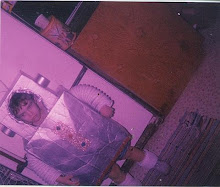A couple of weeks ago, I went to the Robinson Film Center for a rough-cut screening of the documentary Invisible Girlfriend. The film focuses on Charles, who lives in Monroe, Louisiana, and who is in love with the statue of Joan of Arc on Decatur Street in New Orleans. Charles is convinced that “Joanie's” physical manifestation is a bartender named Dee Dee, who he is infatuated with. Since Charles's driver's license is suspended, he buys a bicycle and decides to ride it to New Orleans, some four hundred or so miles to the south. Along the way, he has a series of odd encounters with a number of genuinely strange and engaging people
I'm still not completely sure how I feel about the movie. I saw it with Lindsay, and while I agree that some of her criticisms are accurate, I don't feel they detract from the overall effect of the film. There are a handful of beautiful shots throughout and, while some of them don't entirely work, or are somewhat clumsy, or lose focus, this is simply because the camera being used just can't handle the conditions it's used to shoot in, creating an extremely grainy or unsteady image. I can live with this. Bitching about a blurry shot or a little grain when a movie has been shot by literally two people is like complaining that Bee Thousand doesn't sound like The Colour And The Shape.
There's the inevitable and more concerning question of exploitation, but watching the movie, I never got the impression that Charles was being manipulated or that scenes were in some way scripted. And while Charles is certainly crazy (and though he comes across as more or less harmless, you get the definite impression that his illness has taken darker turns in the past), the film never paints him as some kind of Funny Crazy Guy and never portrays schizophrenia as any kind of fun. Charles is extremely candid and clear-headed in his discussions about mental illness, and during the aftershow Q&A, which he and the filmmakers attended, he was remarkably lucid—though he still seemed to believe that his invisible girlfriend was with him.
Initially, I was troubled by the fact—revealed by Charles during the Q&A—that making the four hundred mile journey by bicycle was actually the idea of the filmmakers. This alone should probably have been enough to cause an outright dismissal of the whole movie, I thought. But, really, so what? The scenes that work best in the film—a farmer proudly showing off his muzzleloader while waiting for a calf to be born; a man who owns a ruined riverboat that he claims belonged to FDR; an old married couple who provide Charles dinner and discuss Walt Disney's cryogenically frozen corpse; a man who owns a strange roadside attraction dedicated to dead US Soldiers, and who breaks down crying while looking over their photos—are absolutely real.
That reality is reinforced in the film's conclusion, which is completely unexpected, focusing on one of those moments when you've been utterly blindsided by tragedy in some public place and you wind up all alone, walled up with your grief, your pain soundtracked by some idiotic song (in this case, a live version of The Doors' “Roadhouse Blues”) blaring in the background. It might be Invisible Girlfriend's single best moment.
The movie's not perfect. And it might not even be completely "real", but it's close enough, I guess.
Moving over to Substack
11 months ago

No comments:
Post a Comment